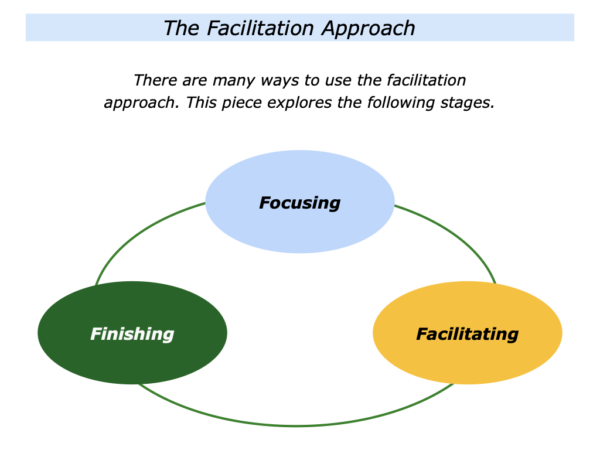
Imagine you have been asked to facilitate a team workshop. Your aim will be to help people to channel their energies towards achieving their chosen goals. This may involve taking the following steps.
Focusing
Clarifying the aims for the session and setting it up to succeed in achieving these aims.
Facilitating
Facilitating the actual session and helping people to work towards achieving the aims.
Finishing
Doing your best to ensure the session finishes properly and, if appropriate, following up to help people achieve their aims.
Before looking at your own facilitation style it can be good to learn from good practice. Martin Gilbraith is a specialist in this field.
Here are excerpts from his website in which he describes the role of facilitation. This is followed by the Six Core Facilitation Competencies described by the International Association Of Facilitators.
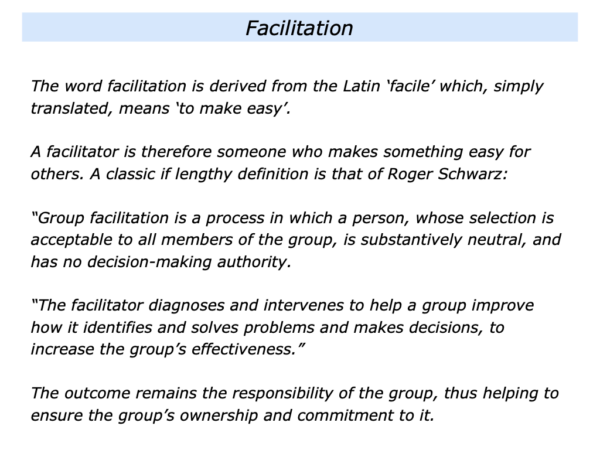
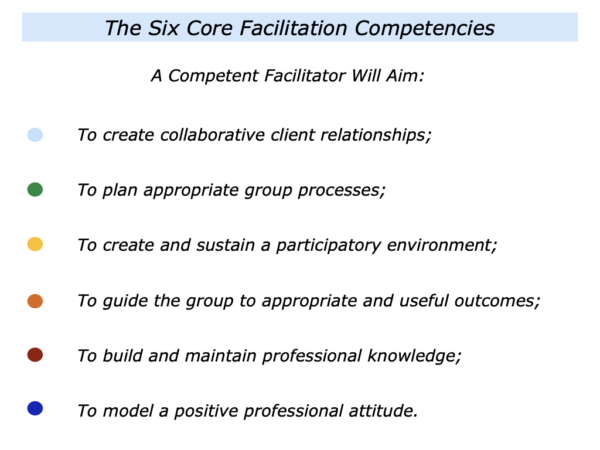
You will have your own approach to facilitating the session. Like many facilitators you will prepare properly. Let’s consider this step.
Focusing
You may start by gathering information about the situation, the people involved and the goals to achieve. You will also aim to set up the session to succeed.
It will be important to meet with the key stakeholders. These may include the team leader and, if appropriate, their manager. It may also include meeting other people in the team.
The following section describes some key themes it can be useful to explore with these people. After gathering information it will be important to make clear contracts with the key stakeholders about:
The specific goals for the session – the picture of success;
The specific guidelines to follow – the Dos and Don’ts – during the session;
The specific roles of various people in the session;
The specific things that can be done to increase the chances of success in the session;
The specific things that can be done to follow up the session and achieve the picture of success.
One approach to gathering information is to explore the What, Why, How, Who, When and Where. The following section provides a framework you can use to explore these questions, but there is one key point to bear in mind. This is a framework rather than a list.
Depending on the situation, you may want to begin by asking about the Who – who will be attending – rather than the What or Why. Like all frameworks, you can adapt it in your own way.
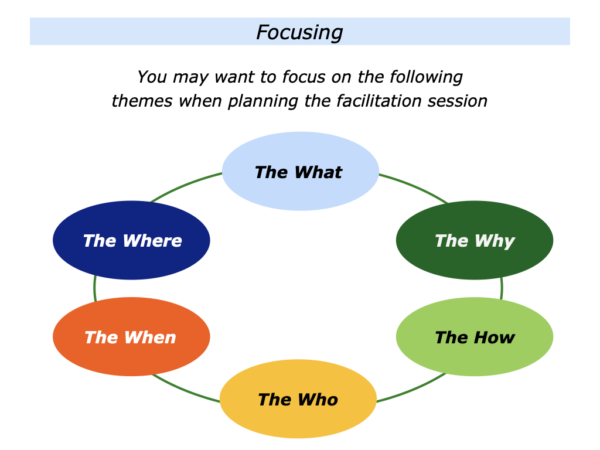
The first step will be to meet with the team leader and, if appropriate, their manager. You can then meet with other people.
Here are some themes you can explore with the individuals. As mentioned earlier, you can pick and mix from the various sections.
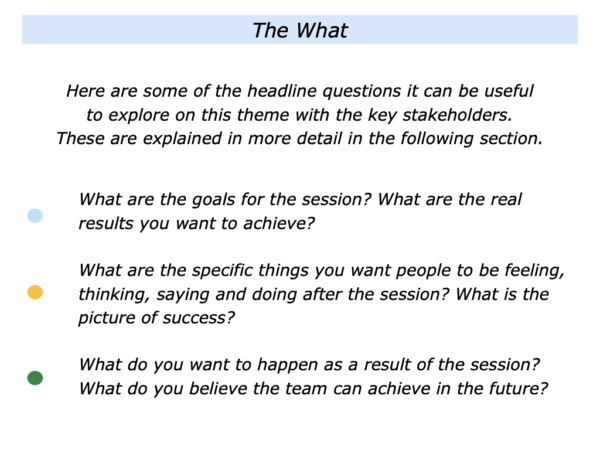
What are the goals for the session? What are the real results you want to achieve? What for you will make it a successful session? What are the specific things you want people to be feeling, thinking, saying and doing after the session?
What is the session expected to produce? For example, does it aim to create a sense of ownership, a clear strategy, an increased sense of motivation, a specific action plan or something else.
What do you want to happen as a result of the session? What may be potential actions you want to implement? What do you believe the team can achieve in the future? What is the longer-term picture of success?
Bearing these things in mind, let me check the goals for the session. As far as I understand it, the results you want to achieve from the session are:
1) To …
2) To …
3) To …
Is that the case? Are there any other things you would like to add?
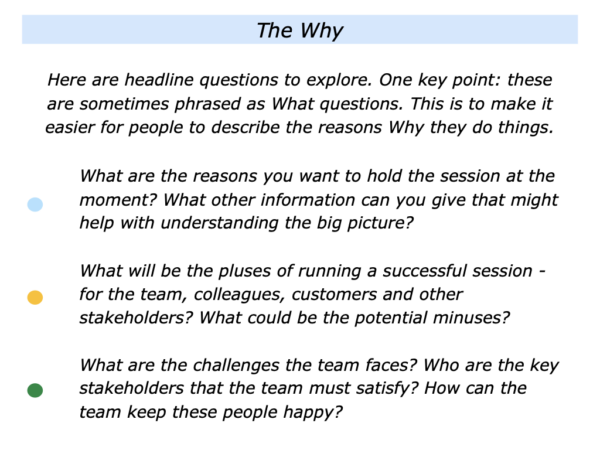
Sometimes it is easier to explore a person’s reasons for doing things by asking them What questions rather than Why questions. This is something I learned when running therapy sessions. There are several reasons for taking this approach.
First, a person may find it easier to answer an open What question rather than a closed Why question. This can help them to loosen up and explore the possible reasons.
Second, some people experience Why questions as a criticism or accusations. They may tighten up or think there is only one right answer.
For example, if a person has asked for your help in changing their negative behaviour, it is difficult for them to answer the question:
“Why do you behave in that way?”
It can sometimes be easier for them to answer if you ask:
“Looking ahead, what do you want to do in the future? How do you want to behave? Would it be okay to explore some ways that you can achieve those results?”
Bearing this in mind, here are some of the questions it can be useful to ask the stakeholders on this theme.
What are the reasons for wanting to have the session? What is happening in the team at the moment? What other information can you give that might help to understand the big picture?
Let’s imagine that the session is successful. Looking ahead, what will be the benefits of achieving the agreed results? What will be potential pluses – for the team, colleagues, customers and other stakeholders? What could be the potential minuses?
Looking at the team, I would like to know a bit more about its history, successes and challenges. Can you tell me about the history of the team?
What are the factors that have brought it to this point of wanting to have a session? What are the challenges facing the team? What have people tried before to tackle these challenges? What were the results of these efforts?
Let’s have a look at the team’s strengths. Looking back, when have people in the team worked well together? What did they do right then? How do you think they can follow these principles – plus maybe add other elements – to work well together in the future?
Looking at the team at the moment, what does the team do well? How can it do more of these things in the future? What can the team do better in the future and how?
Who are the key stakeholders that the team must satisfy? What do each of these stakeholders want? What do your backers, bosses and customers want? How can people in the team do their best to keep these people happy?
Are there any other factors I need to know regarding the team’s future? How long do you think some of the people will be around? What do you think your organisation sees as the future of the team? Is there anything else it would be helpful to know?
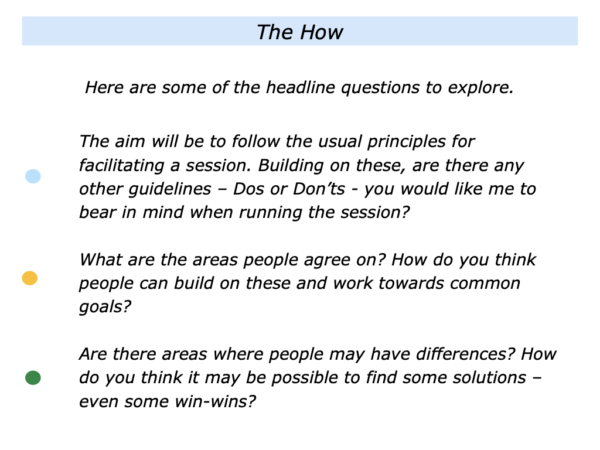
Let’s move on to some of the guidelines it would be useful to follow during the session. It will also be important to agree on the responsibilities of various people during the session. For example:
My Responsibilities Will Be:
To create a positive environment; to make clear contracts about the goals for the session; to explain what I see as my responsibilities and the team member’s responsibilities in working towards achieving the goals;
To explain it will be important to encourage each other, listen and, when appropriate, work together to find positive solutions; to help people to achieve the agreed goals. To do my best to ensure they go away saying things like:
“That was a good session. We used our individual and team strengths to find solutions to challenges. We now have an action plan that we believe in and will do our best to achieve the goals.”
The Team Members’ Responsibilities Will Be:
To maintain a positive environment; to agree on the goals; to encourage each other; to work together to find solutions to challenges; to conclude the session by making clear plans; to have mission holders who will take responsibility for ensuring the plans are carried out; to then get some quick successes.
Are there any other guidelines – Dos and Don’ts – it would be useful to follow to improve the chances of having a successful session?
My approach is often to build on what people have in common and, when appropriate, find solutions to any differences. Bearing this in mind, it would be good to know about the following things.
What do people already agree on? What are the areas where people want to work towards common goals? How do you think people can build on these in the future?
What are the areas where people may have differences? If so, what are the different views, feelings or approaches they have?
If appropriate, I may be able to help people to find some solutions. This is something we can explore. Are there any particular areas where this might be helpful?
Decision making is vital and at times somebody simply needs to make a decision. Bearing this in mind, let me ask a couple of questions.
What may be the specific areas where – despite attempts to find agreement – you or other key people may simply need to make a decision? What may be the pluses and minuses of taking this route?
Is there anything else you want to say or ask me about regarding how we conduct the session?
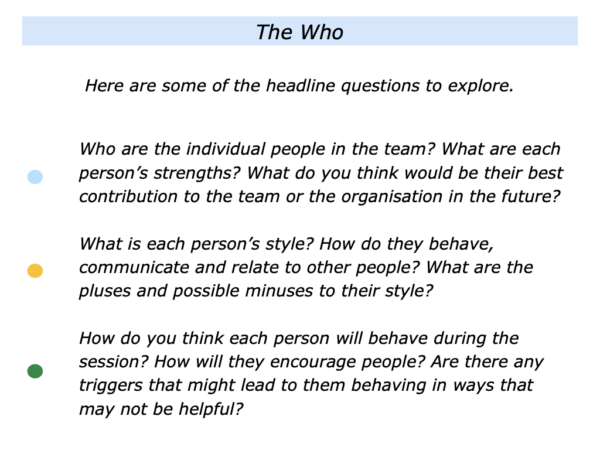
Who are the individual people in the team? What are their specific roles? What are the results they are accountable for delivering in each of their roles?
What are each individual’s strengths? When do they do good work? What do they do right then? What are the principles they follow? What do you think would be their best contribution to the team or the organisation in the future?
What is the person’s style? How do they behave, communicate and relate to other people? What are the pluses of their style? Are there any potential minuses to their style? What are the consequences?
Looking at each person, how do you think they will behave during the session? How will they encourage and support people? Are there any triggers that might lead to them behaving in ways that may not be helpful?
Let’s revisit the various roles in the session. My role is to do my best to guide the team to success.
Looking at your role – as a leader or manager – what role do you want to play in the session?
You will, of course, be a participant. During some parts of the session, however, you may want to introduce a topic, give some background or play another role. At that point it will be important to let the group know that you are taking that role for a certain time.
Decision making is important. Bearing this in mind, who will ultimately make the key decisions regarding various topics? Who will then be following up the work that is done during the session?
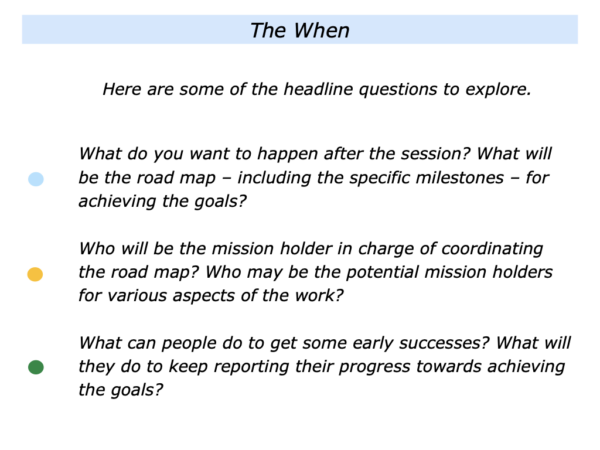
Looking ahead, let’s imagine the session goes well. What do you want to happen afterwards? What would like to see delivered and by when?
What do you think could be the kind of action plan and timetable? What will be the road map – including the specific milestones – on the road to achieving the goals?
Who will be the mission holder in charge of coordinating the road map? Who may be the potential mission holders for various aspect of the work? What will be their brief? What support will they need to deliver the road map successfully?
Looking ahead, what can you do to maintain the momentum? What can you do to get some early successes? What can people do to produce some quick wins?
What can people do to proactively report their progress towards achieving the goals? What else needs to happen – and when – to ensure the team has a good chance of achieving its goals?
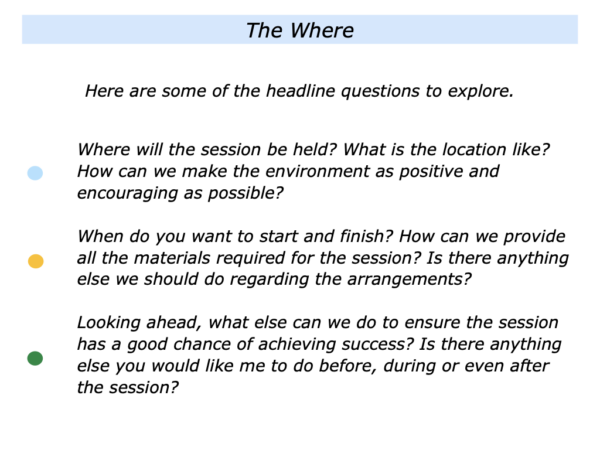
Where will the session be held? What is the location like? How can we make the environment as positive and encouraging as possible? How can we make sure the physical and emotional things are right?
What will be the timings for the session? When do you want to start and finish? I will organise the session so that people can do the work but also have regular breaks.
How can we provide all the materials required for the session? Is there anything else we should do regarding the arrangements? Who will be in charge of making those happen?
When will people be informed about the session? What do you want to tell them about the agenda and goals? What do you want to say about the attitude that will be required for us to achieve success?
Looking ahead, what else can we do to ensure the session has a good chance of achieving success? Is there anything else you would like me to do before, during or even after the session?
You may then want to summarise the discussion by saying something like the following to the stakeholders.
“Looking at what you want to achieve, here is a potential framework for the day.
The Goals For The Session Are:
*
*
*
The Schedule For The Session – Including
The Topics We Will Cover – Will Be:
*
*
*
*
*
*
“Is there anything you would like to add or change? Bearing this in mind, I will send an email confirming the goals and timetable.
“Let me know if you have any further thoughts or want more information. Otherwise I will see you on the day. Is that okay?”
Preparing For The Session
Imagine that you have gathered all the information. You may then take time to reflect and rehearse the session. Bearing in mind the controllables – the things you can control – you may aim:
To focus on the goals for the session;
To settle on your plans for running the session;
To rehearse running the session.
Different people rehearse in different ways. You may, for example, look ahead and rehearse going through the following steps.
Travelling to the location … Getting there at least an hour before the start … Setting up the room … Preparing any flip charts and making sure all the equipment works.
Completing the preparation and giving yourself time to think … Again rehearsing the day in your head … Greeting each person as they arrive … Making them feel welcome.
Starting the session … Inviting the leader to give an introduction to the day and what they would like the team to achieve … Confirming the agreed goals … Explaining the format and schedule for the day.
Making clear contracts about your role and the participants’ roles … Explaining the key principles to follow during the day – such as encouraging each other and working to find solutions … Asking if people have anything to add to the agenda.
Moving onto the first topic on the agenda … Introducing the topic by explaining the concept and giving concrete examples … Giving exercises or other ways of helping people to explore the topic.
Being encouraging … Enabling people to produce ideas or solutions for tackling challenges … Building on areas of agreement … Making action plans … Making the transition to the next topic.
Moving on to any areas where people may have differences … Helping people to clarify what they each want … Using creative problem solving methods to help people to find, as for as possible, win-win solutions.
Anticipating any possible difficulties during the day … Clarifying how you can prevent these difficulties happening … Clarifying how you can manage them if, despite everything, they do happen.
Continuing to work through the agenda … Reaching the final part … Handing over to the leader to explain the next steps … Making sure the team has mission holders who will take responsibility for delivering aspects of the action plan.
Giving a short exercise before finishing … Inviting people to share what they have learned or relearned during the day … Thanking people … Handing over to the leader to conclude the day.
You may wish to complete your preparation by clarifying the Dos and Don’ts for running the session. For example:
Do encourage people; Do focus on the results to achieve; Do focus on areas of agreement; Do encourage people to find solutions; Do keep connecting with the key stakeholders to ensure they are happy with the process.
Do stay calm; Do buy time to think if the group hit trouble; Do think of the possible ways forward; Do rehearse taking the next steps; Do everything possible to help the team to reach its goals.
There may be other guidelines you wish to follow. The Don’ts may probably be the inverse of the Dos. If you wish, try tackling the exercise on this theme. This invites you to complete the following sentences.
Facilitating The Session
The Dos to bear in mind when
facilitating the session are:
* Do …
* Do …
* Do …
The Don’ts to bear in mind when
facilitating the session are:
* Don’t …
* Don’t …
* Don’t …
Facilitating The Actual Session
Before setting out for the day, you may rehearse again the overall plan for running the session. Getting to the venue early, you will make sure everything is in place.
You will welcome people and then invite the team leader – or other key stakeholder – to set the scene for the day. They will hand-over to you to run the session.
One approach is to simply start by giving people an overview of the schedule for the day. You will then run the session in your own way.
Here is an introduction to some of the steps you may want to take, however, on the way towards helping people to achieve their goals.
Confirm The Goals For The Session
People will already have been sent an introduction to the goals for the session. Bearing these in mind, you can describe these again. You may say something along the following lines.
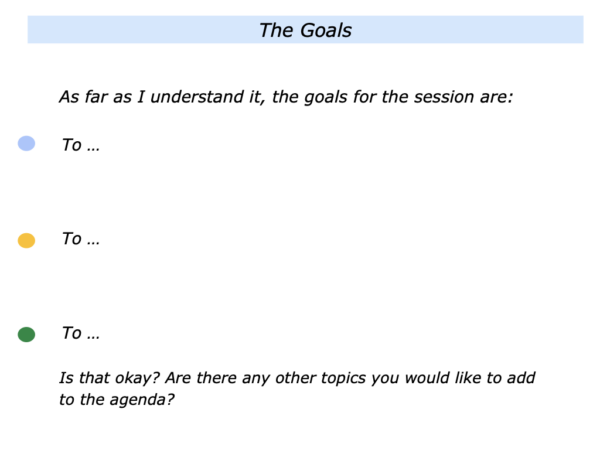
Make Clear Contracts About
People’s Roles In The Session
Explain your own and the participants’ roles in working towards achieving the goals. Done in a positive way, this can help to set the tone for the session.
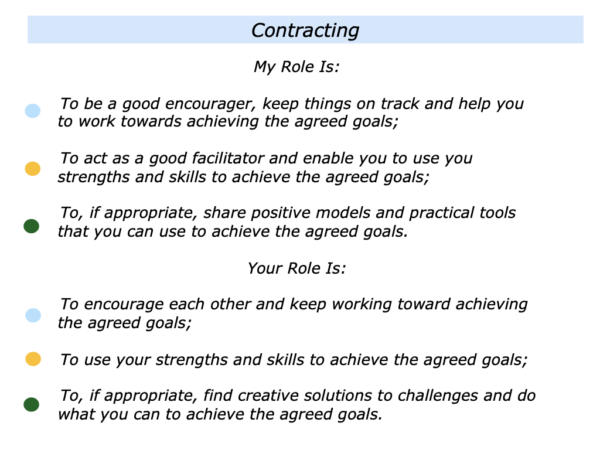
If appropriate, you may also want to outline some of the guidelines for the session. These may only be necessary if there is a likelihood of people behaving in ways that may cause difficulties for others. These kinds of guidelines may include the following.
One person to speak at a time; Respect each person’s views; Seek to understand what the person is saying before responding; Build on the areas of agreement; Solve any conflicts by asking: “How can we, as far as possible, get a win-win?”
Be A Good Model By Being
Positive And Encourage People
Good facilitators are often calm, clear and create an environment in which people can achieve concrete results. Your own behaviour can set the tone for the group. It can therefore be useful to try to act as a good model.
Focus On The First Topic To Explore
Introduce the first topic to explore. People need context so, if appropriate, show how tackling this topic will help towards achieving the overall goals. You can also describe any models or tools they can use to focus on the particular topic.
Follow Your Chosen Approach For
Helping People To Reach Their Goals
You will have your own approach to facilitating the discussions. When appropriate, you may also introduce exercises and breakout sessions that enable people to work on the themes. The important things to bear in mind are:
To use an approach that is likely to work;
To customise the approach to make it work in the situation;
To do your best to help people to achieve the goals.
Many models apply versions of the What, How, When approach. Here is an introduction to some questions that it can be useful to invite people to explore when using this approach.
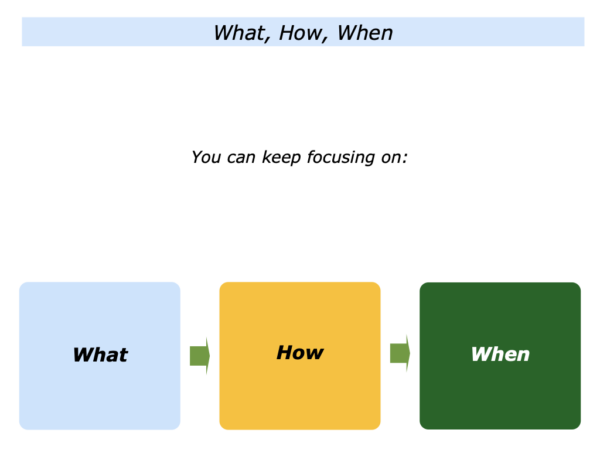
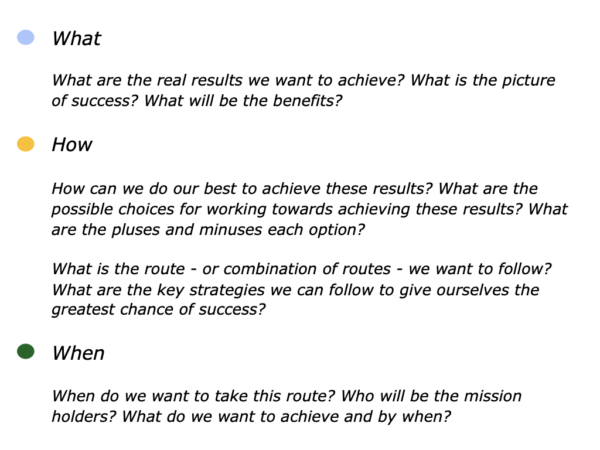
Encourage People To Build
On Their Areas Of Agreement
Good teams build on areas of agreement. Bearing this in mind, you may occasionally say things like:
“Let’s clarify what we have agreed on so far. As far as I understand, the things we have agreed on are:
1) …
2) …
3) …
“We can translate these into action and get some early successes. We can then, when you are ready, focus on how we can find solutions to any topics where there may be differences.”
On Occasions It May Be
Okay To Move Into Other Roles
Your role is to act as a facilitator and help people to achieve the goals. Depending on your approach, this can also involve providing stimulating input, such as summaries, models and tools.
There may be some rare occasions, however, when it may be helpful for you to move into another role. This is more likely to be the case if you are working with the team in other roles, such as a mentor.
If you want to step out of the facilitator role in the session, it will be important to position this by saying something like:
“With your permission, I will step out of the role as a facilitator for a moment and take the role of … then I will go back into the role.”
This should only be done if it is appropriate and will help people in the session. Then, after giving a piece of input, you can move back into the role of facilitator.
Conclude Work On The First Topic
And Move On To The Next Topic
Ensure that people have got as far as they can with the first topic. You may then want to say something like the following.
“As far as I understand it, you have agreed upon the following things:
1) …
2) …
3) …
“Bearing these in mind, it can be a good time to take a break. Before we do that, however, let’s agree on the next topic you want to explore.
“Here are the other topics on the agenda. We can, of course, add other points. Looking at these topics, which one would you like to focus on after the break?”
Keep Connecting With
The Key Stakeholders
Choose your own way to keep in touch with the key stakeholders during the session. It can be useful to catch up with them occasionally and say something like the following.
“Are you okay with how things are going?
“Looking ahead, the next topics we will be focusing on will be …
“Are there any other things you would like me to bear in mind or are there any other topics you want us to explore?”
Keep connecting with them. Ensure they are happy with how things are going and, where necessary, make alterations to ensure the session achieves its goals.
Buy Time To Think When Necessary
There could be challenging moments during the session. People could get stuck, fall into arguments or hit other difficulties. If these happen, it can be useful to buy time to think.
Stay calm and use your own approach to finding solutions to challenges. As mentioned earlier, one way is to keep asking yourself:
“Looking ahead, what are the real results we want to achieve? What is the picture of success? What will be happening that will show we have achieved the picture of success?”
“How can we do our best to achieve those results? What are they key things we can do to give ourselves the greatest chance of success? If appropriate, what can we do to – as far as possible – get win-wins?
“How can I help people to take these steps? How can I share the possible ways forwards? How can I help people to take their chosen route towards achieving the desired results?”
If appropriate, consider using some of the tools described elsewhere in this book. These include helping people to find win-win solutions or work towards a compelling Third Side.
Clarify the specific things you can do to help people. Rehearse what you are going to do next. You can then do your best to help people to achieve the desired results.
Finishing
Continue until people have completed the agenda and or feel they have done what they can during the session. If appropriate, you can finish by asking each person to write down the following things.
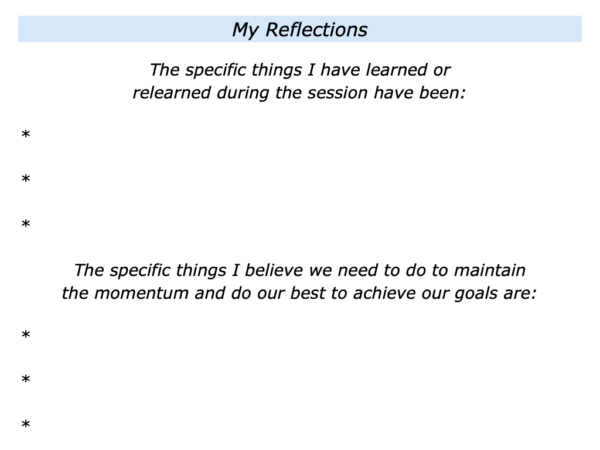
If it is a relatively small group of up to twelve people, you can then invite each person to describe what they have written. If it is a larger group, you can invite people to share their ideas in pairs or trios. This helps to reinforce a feeling of success.
Finish Your Part of The Session And
Hand Over To The Key Stakeholders
Find a way to catch up with the key stakeholders. Say that you will be handing over to them at the end of the session. Explain that it may be good for them to conclude the session by outlining the next steps.
They will, of course, do this in their own way. One approach is for them to cover the following areas.
To thank people for their contributions and to summarise what has been agreed;
To explain the next steps regarding the actions to implement and the mission holders who will take responsibility for ensuring these are delivered;
To describe some quick successes they as leaders are going to deliver to maintain the momentum on the way towards achieving the team’s goals.
If the key stakeholders are happy to do this, you can conclude your part of the session and hand over to them. They can then aim to finish the session in a positive way.
Following Up
The session will probably result in some kind of outcome. This could be project work, an agreed action plan or other activities.
If requested by the key stakeholders, you could help them with the follow up. Depending on your skill set, these may include opportunities:
To facilitate further sessions with the team;
To hold individual mentoring sessions with the team members;
To use your strengths to help the team to achieve its picture of success.
If you wish, try tackling the final exercise on this theme. This invites you to describe how you can do your best to finish the session in a positive way.
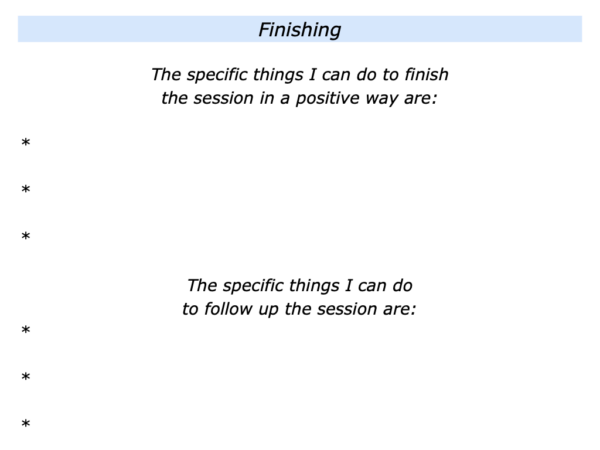






Leave a Reply